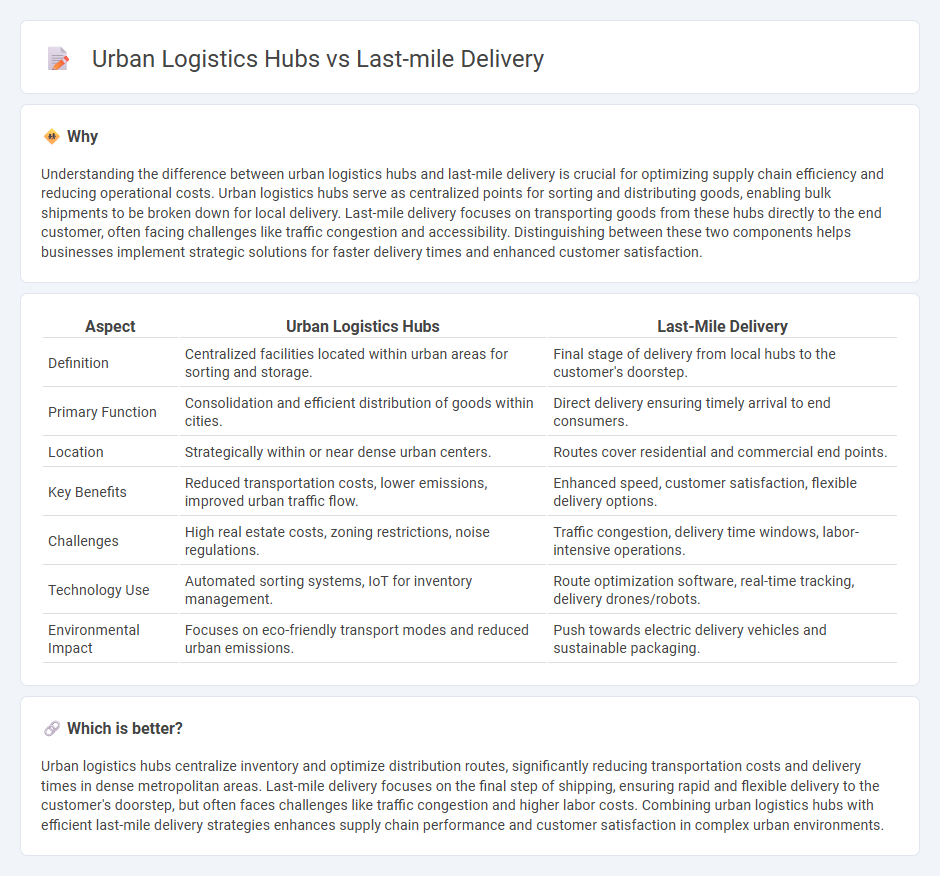
Urban logistics hubs centralize storage and distribution closer to city centers, enhancing efficiency by reducing transit times and lowering transportation costs. Last-mile delivery focuses on the final step of the supply chain, ensuring swift and accurate delivery directly to consumers, often facing challenges like traffic congestion and limited parking. Explore the evolving strategies and technologies shaping urban logistics hubs and last-mile delivery to optimize city freight movement.
Why it is important
Understanding the difference between urban logistics hubs and last-mile delivery is crucial for optimizing supply chain efficiency and reducing operational costs. Urban logistics hubs serve as centralized points for sorting and distributing goods, enabling bulk shipments to be broken down for local delivery. Last-mile delivery focuses on transporting goods from these hubs directly to the end customer, often facing challenges like traffic congestion and accessibility. Distinguishing between these two components helps businesses implement strategic solutions for faster delivery times and enhanced customer satisfaction.
Comparison Table
| Aspect | Urban Logistics Hubs | Last-Mile Delivery |
|---|---|---|
| Definition | Centralized facilities located within urban areas for sorting and storage. | Final stage of delivery from local hubs to the customer's doorstep. |
| Primary Function | Consolidation and efficient distribution of goods within cities. | Direct delivery ensuring timely arrival to end consumers. |
| Location | Strategically within or near dense urban centers. | Routes cover residential and commercial end points. |
| Key Benefits | Reduced transportation costs, lower emissions, improved urban traffic flow. | Enhanced speed, customer satisfaction, flexible delivery options. |
| Challenges | High real estate costs, zoning restrictions, noise regulations. | Traffic congestion, delivery time windows, labor-intensive operations. |
| Technology Use | Automated sorting systems, IoT for inventory management. | Route optimization software, real-time tracking, delivery drones/robots. |
| Environmental Impact | Focuses on eco-friendly transport modes and reduced urban emissions. | Push towards electric delivery vehicles and sustainable packaging. |
Which is better?
Urban logistics hubs centralize inventory and optimize distribution routes, significantly reducing transportation costs and delivery times in dense metropolitan areas. Last-mile delivery focuses on the final step of shipping, ensuring rapid and flexible delivery to the customer's doorstep, but often faces challenges like traffic congestion and higher labor costs. Combining urban logistics hubs with efficient last-mile delivery strategies enhances supply chain performance and customer satisfaction in complex urban environments.
Connection
Urban logistics hubs serve as centralized distribution centers that streamline last-mile delivery by consolidating goods closer to the final destination, reducing transit times and traffic congestion. These hubs optimize route planning and vehicle loads, enhancing delivery efficiency and sustainability in dense city environments. Effective integration of urban logistics hubs with last-mile delivery networks supports faster fulfillment, decreases carbon emissions, and improves overall urban mobility.
Key Terms
**Last-mile delivery:**
Last-mile delivery refers to the final step in the supply chain where goods are transported from distribution centers directly to the customer's doorstep, emphasizing speed and efficiency to meet consumer expectations. Urban logistics hubs serve as centralized points within city areas that facilitate the storage and redistribution of packages, thereby supporting quicker last-mile delivery by reducing travel distances and congestion. Explore how integrating last-mile delivery strategies with urban logistics hubs can revolutionize urban supply chains and customer satisfaction.
Route optimization
Last-mile delivery efficiency significantly improves when integrated with urban logistics hubs, leveraging advanced route optimization algorithms to reduce travel distance and delivery time. Urban logistics hubs serve as strategic consolidation points, enabling dynamic routing and real-time traffic data application to enhance delivery accuracy and sustainability. Explore how cutting-edge route optimization technologies transform last-mile delivery within urban logistics frameworks for smarter, faster distribution.
Fleet management
Last-mile delivery emphasizes efficient fleet management to minimize delivery times and reduce operational costs, leveraging GPS tracking and route optimization software. Urban logistics hubs centralize vehicle dispatch and consolidation, enabling better fleet utilization and reducing congestion through coordinated scheduling. Explore how integrating these approaches enhances fleet management and urban delivery efficiency.
Source and External Links
Last mile delivery: solutions for your business | DHL Discover - Last mile delivery is the final leg of a product's journey from a local distribution center to the end consumer, focusing on affordability, speed, and accuracy, often by road or drop-off points, with growing consumer demand for rapid and traceable delivery options.
What is a Last Mile? Complete Guide to Last Mile Delivery & Logistics - Last mile delivery is the critical final step that brings goods directly to customers, with technology like route planning and real-time tracking helping reduce delivery times and improve customer experience.
What is Last Mile Delivery? Everything You Need to Know - Onfleet - Last mile delivery involves the movement of parcels from transportation hubs to the final destination, comprising key steps such as order management, routing, delivery assignment, and customer communication to meet growing demands for faster shipping.
 dowidth.com
dowidth.com